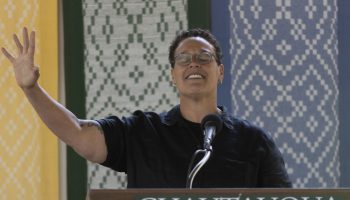L. Sebastian Purcell said the “tongues of fire in the sky” and “the roof of the sun god catching on fire” were both bad omens, leading Aztecs to a collective fear.
Purcell, a scholar of Aztec philosophy and professor at SUNY Cortland, dissected this Aztec fear and anxiety in his Thursday lecture “From Anxiety to Happiness? What Aztecs Can Teach Us about the Good Life,” part of Week Seven’s Interfaith Lecture Series, “Spirituality in an Age of Anxiety,” in the Hall of Philosophy.
“(The Aztecs) lived, we could say, in a general cosmic anxiety, that everything might just go ‘poof,’ ” Purcell said. “Our modern anxiety, of course, is different. The Aztec anxiety would appear to be rooted in a religious worldview; our anxiety is rooted in, maybe, the lack of any dominant religious worldview.”
This introduces the question: Can society today embrace these Aztecan methods of planning for “the good life”? The ideas the Aztecs presented are, in fact, philosophically obscure, according to Purcell. So much so that if someone was to take a Ph.D.-level philosophy course, he said, the Aztecs would probably never be mentioned. In the 1540s, Catholic clergymen transcribed found material of Aztec culture, but the Aztecs were not considered philosophical.
“What I’m going to present to you isn’t in a book — I’m sorry, I’m still writing it,” he said.
Purcell said the most effective way to examine Aztecan ethics is through taking a look at their metaphysics.
“The basic question of metaphysics as it’s discussed in the West can be posed in three words,” Purcell said. “The question is: What is there? And it can be answered, moreover, in just one word: Everything.”
Nahuatl, the Uto-Aztecan language of the Nahuatl people, cannot accurately ask these questions when translated into English. According to Purcell, the language is “omni-predicative.”
“At base, there’s no fundamental difference between nouns and verbs for the constitutive components of a sentence,” he said. “Basically, everything is a verb.”
This all-encompassing motif can be seen in the concept teotl: the fundamental energy of existence, the only thing in the universe from which everything stems. Although Westerners and Spaniards were under the impression Aztecs were polytheistic, teotl proved it was not so.
“Our modern anxiety, of course, is different,” Purcell said. “The Aztec anxiety would appear to be rooted in a religious worldview; our anxiety is rooted in, maybe, the lack of any dominant religious worldview.”
Differing from these Western societies was the Aztecs’ idea of the “sacred versus the profane,” Purcell said. Westerners have a dichotomy that paints religion as “unchanging, eternal and pure” and the world as “changing, perishable and impure.” Meanwhile, teotl operates more on a harmonic-anharmonic system.
“They held, basically, (that) reality comes in kind of doubled pairs, sort of a brute fact of reality: day, night; man, woman; life, death; light, darkness,” Purcell said.
Teotl is also seen as a struggle between two sides of competing pairs. For example, “night wins out over day, wind wins out over fire and death wins out over life.” This one-sided victory is said to keep a balance between the contesting sides.
There is also only one victory — that of the “fifth sun” — in the legend of the Five Suns. The legend speaks of four suns previously created and destroyed, representing past attempts at life. This fifth sun is said to be the present day. Aztec people saw it as their duty to provide the sun its nourishment; to prevent the sun’s disappearance, they offered blood and heart sacrifices.
“Unlike Western religions that give a sort of solace in the face of death, the Aztec worldview gives us more anxiety,” he said. “It doesn’t tell you, ‘Oh, don’t worry, there’s an afterlife, it’s OK.’ It says, ‘No, no, no. Everything’s going to go away. You’re going to die, the whole cosmos is going to die, that’s it.’ ”
So when it comes to the good life, Purcell considered a college course he teaches at SUNY Cortland, which he titled “Happiness.”
“It was intended to be for advanced philosophy majors, but it ends up being picked by a bunch of seniors in the second semester of their year,” Purcell said. “So just before they go out into the world, they get one last class: how to be happy.”
On the first day of the course, he asks students if they want to be happy, and immediately, almost every hand is in the air. When asked what elements are most central to this happiness, students most often answer “relationships” — sometimes, “children.”
“Then I will, over the next 10 to 15 minutes, give them a thorough marinating in the data that we have about children, and it turns out that, rather unequivocally, children don’t make you happy,” he said.
But even after this explanation, when Purcell polls the class about who wants to have children, the same hands go up. This desire, he said, is linked to the Aztecs’ idea that humans value worthwhile lives over happy lives. Understanding this is the first step in seeking the good life.
With this in mind, Purcell explained the Aztec saying “the Earth is slippery.” The subtext: Someone of “the good life” might fall into something wrong, similar to slipping in the mud.
“Descriptions seem to include willed and nonwilled actions, that is, actions that are candidates for moral evaluation and things that look more like reflexes,” he said. “Slipping in the mud? Not a candidate for moral evaluation. Taking a paramour certainly is.”
But this idea of the slippery slope, Purcell said, misses the point. Instead, a better characterization of life on Earth might be the image of Earth as a razor’s edge, with someone inevitably falling on one side or the other.
“The slipperiness doesn’t seem to be the result of error in reasoning,” Purcell said. “At some point, bad things happen to good people. The best laid plans are often dashed just as they begin. Purity isn’t the goal. The best that we can hope for is to manage the errors that we commit well, not to live an un-erring life.”
His first observation of Aztec philosophy, then, is that people slip up. This is seen in a poem by Aztec philosopher Nezahualcoyotl, which begins, “my friends, stand up/ the princes have become destitute” and later says, “take your chocolate/ flower of the cacao tree/ may you drink all of it!” The dismal-turned-triumphant pattern shows up again, turned on its head, in 1 Corinthians 15:32, which includes the phrase, “Let us eat and drink, for tomorrow, we die.”
To avoid some slipping up, Purcell said, the Aztecs prescribed four levels of “taking root” they believed to be essential to “the good life.”
The first was taking care of the body, particularly through a daily yoga regimen, something “young and old alike” were capable of doing to center themselves.
“In Western philosophy, the role of body in ethics is almost completely neglected,” he said. “Philosophers tend to act as if, ‘Oh, well yeah, that’s a thing you have, and that’s it.’ ”
The second level was balancing the psyche, often said to have two fundamental features: the head and the heart.
Purcell gave the example of a father wanting his son to be more moderate. The father prescribes a fast to his son, giving him one tortilla to eat during the day. The son has three options: eat the full tortilla in the morning, split the tortilla throughout the day or wait to eat the tortilla at night. No matter what the son does, he will have learned moderation.
Thirdly, Aztecs believed in the value of social cooperation.
“We’re all fathers and mothers or students and professors and day laborers and business analysts, soldiers, civilians,” Purcell said. “They would have had feather workers and cobblers and leather tanners and things like that. We all have social roles, and we can do them well or fail to do so.”
And finally, the fourth level was philosophizing. This was mostly reserved for the educated and was their “direct contribution to the balance of the universe.”
“A rooted life would thus be worthwhile, meaningful, for one is rooted in one’s body, one’s psyche, one’s community and broader cosmic horizon,” he said.
One question people often have, Purcell said, is whether these words, when put into action, actually work. He says yes. His co-worker Andy Fitzgibbons is living proof. Fitzgibbons’ day typically follows this schedule: tai chi, hot tub, breakfast with wife and foster children (of whom he and his wife have taken in 100) and work (where he often has to cancel meetings for his position on a bioethicist medical review board.) Fitzgibbons’ “mental commitment to love” is consistent with his bodily care, relationships and valuable work.
The other question: Can the general humanity “take this up” in the modern period?
“These questions, I think, hang like swords over the whole modern experience,” Purcell said. “I can’t really treat them in a conclusion, but perhaps I can blunt their edge a little bit.”
As Purcell summarized his final points, he recounted his days in a jazz band and recalled the beauty of the solos his fellow musicians would play — solos that were never recorded or repeated.
“The brevity of existence seemed not to count against their beauty, against the … value they had in their universe,” he said. “Neither was that value diminished by whoever happened to be listening to those solos or not.”
In conclusion, Purcell suggested that each of our actions is like that ephemeral note in a solo, “never to be repeated, recorded, or perhaps, even remembered.”
“Our choice is whether to make of it a beautiful piece or not, to give it value or to degrade it,” Purcell said. “In leading a rooted life, we balance and harmonize its aspects. It looks to be a way that we might give our lives a more beautiful shape, to give them value, and if that’s right, then it matters not whether our lives are short or if there is some transcendent being to watch them. We have it in us, to use this phrase from the Aztecs, ‘to make broken spears of all the threats to our life’s worth,’ and that might just be the best reason anyone has for doing anything anyway.”





